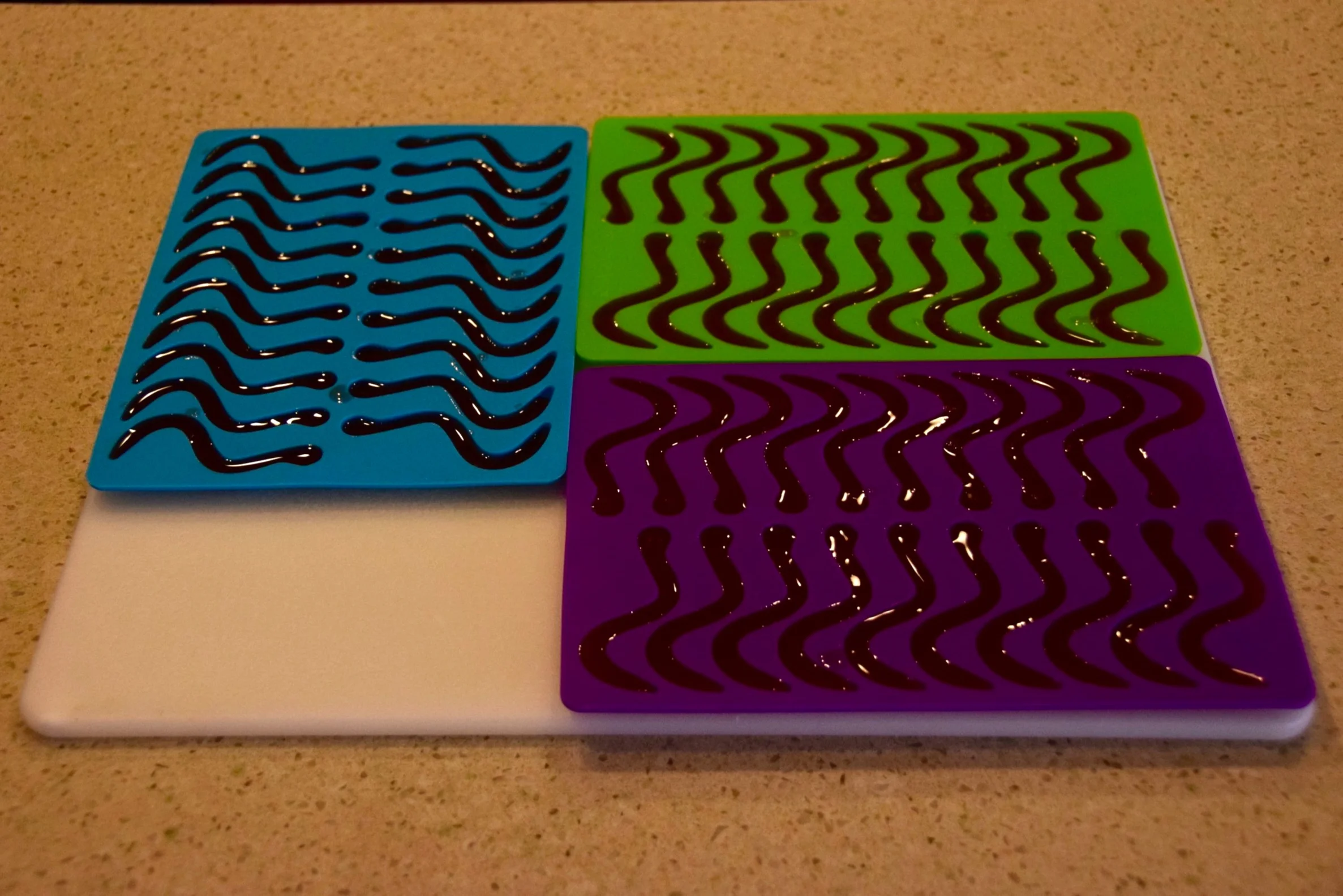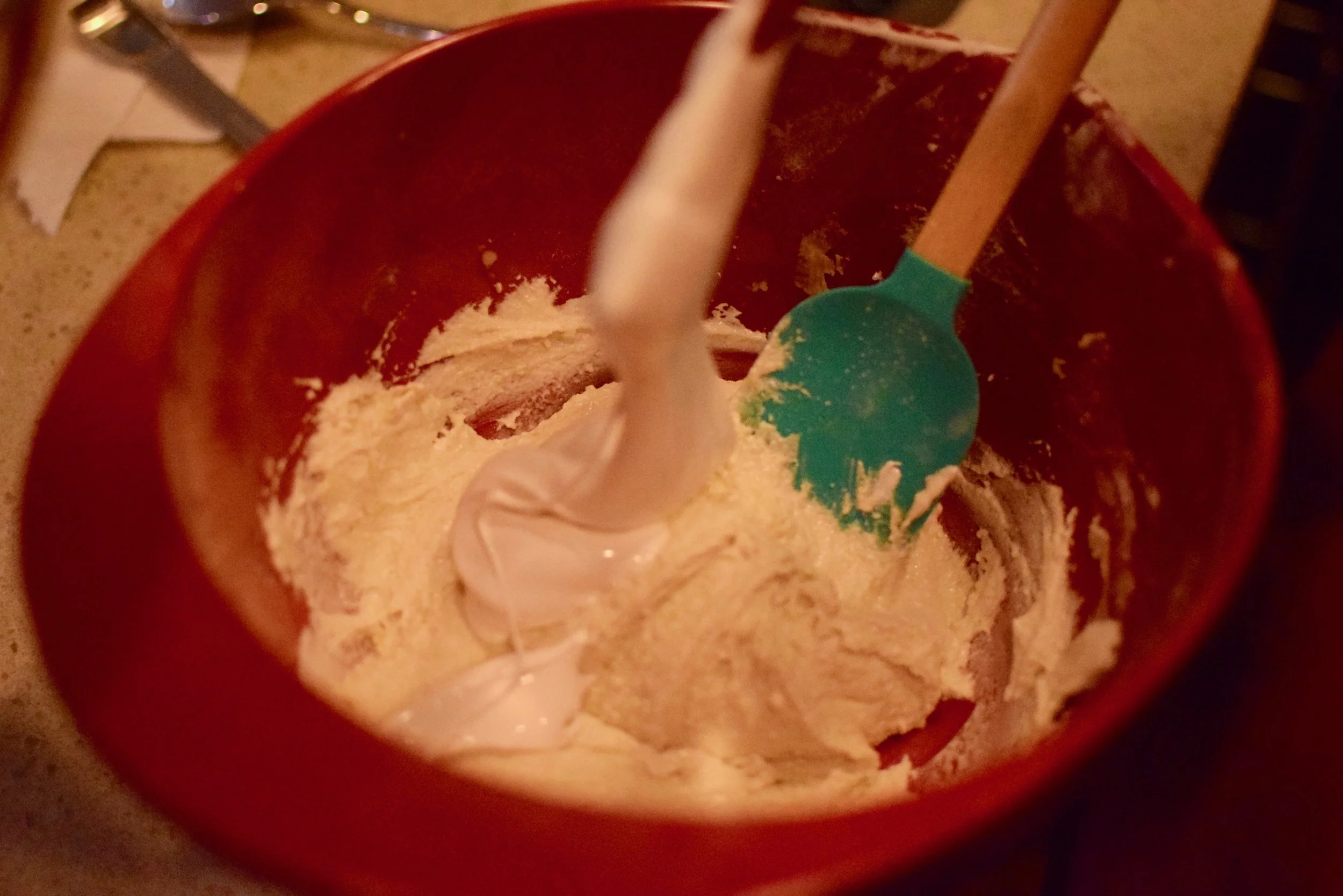Baked: April 7, 2019
Recipe Sources:
“Oreo” Cookies - Food Network
All Natural Gummy Worms - Bigger Bolder Baking
Chocolate Pudding - CIA Baking and Pastry Book
Photo Credit: Daniel Beauboeuf
Happy Earth Month! While Earth Day is April 22nd, I thought I’d kick things off a little early with some earth-themed treats. I remember growing up in the midwest, every kid’s mom or dad would make a treat for their child to bring to school on his or her birthday. While most often it was cupcakes from a box (I’m not judging! Confetti cake is the best…), there was always that special moment when some parent went a step further (or perhaps took the easy route?) and made Dirt Cups. For those who have never heard of Dirt Cups, a Dirt Cup is special treat made of layers of crushed Oreo cookie and chocolate pudding, with gummy worms “crawling” out of the “dirt.” The easy way to make Dirt Cups is to buy crushed Oreos, pre-made chocolate pudding and gummy worms and then just assemble.
But of course for this challenge, I had to make everything from scratch!
My gummy worms are all natural with a base of strawberry puree and honey, I actually made “Oreo” cookies, and the chocolate pudding is the recipe from the CIA Baking and Pastry book. While it was fun to make everything from scratch, this is definitely the most time-consuming way to make a Dirt Cup. Let’s just say that if I ever have kids, I will definitely make them Dirt Cups for school on their birthday … but I assume I will be far too busy to make them from scratch!
Raise your hand if you think we should make “PANGEA - cakes” for breakfast on Earth Day?! Let’s get started…
Basically every step of this bake required some chilling time. I ultimately elected to first make the “Oreo” dough which is similar in consistency to sugar cookie dough. This way, this dough could chill while I made the gummy worms and the pudding, and then be ready later for circle-cutting and baking. So overall, the steps to homemade Dirt Cups consisted of:
Make “Oreo” dough, roll it out, and chill
Make the gummy worm solution, pipette into molds, and chill
Make chocolate pudding and chill
Cut “Oreos” and bake
// Overnight //
Remove worms from molds, crush “Oreos,” and assemble Dirt Cups
Step 1: Make “Oreo” dough, roll it out, and chill
First, I creamed the butter and sugar until they just came together. I then added the eggs one at a time, incorporating fully after each addition. I then added the vanilla and continued to mix.
Prior to the above steps, I had sifted together the flour, salt and cocoa. At this step, I added this dry mixture slowly to the wet mixture. Scraping the bowl once, I continued to mix until the batter, quite dense, came together. I then separated the batter into two portions, dropping each portion onto separate pieces of parchment paper.
Next, I placed another piece of parchment paper on top of each portion of “oreo” dough and slightly flatten the piece of dough using my hands. Once the dough was roughly ~1 inch thick, I used a rolling pin to continue to evenly flatten the dough to about 1/4th inch thick. Since I was using a rolling pin on top of parchment paper, this often involved holding the parchment paper in place with my left hand while I pushed the rolling pin with my right hand. Once both pieces of “Oreo” dough were rolled out, I placed them in the refrigerator to chill as I made the gummy worms and pudding.
Step 2: Make the gummy worm solution, pipette into molds, and chill
Making Gummy Worms from scratch was surprisingly easy, but it does require the right tools. Before embarking on this bake, I ordered these fun silicone molds off of Amazon, below shown filled with my gummy worm solution.
I found a great recipe online that uses all natural ingredients for the Gummy Worms… so of course they are healthy… right? This simple recipe has five ingredients: strawberries, water, lemon juice, honey and gelatin.
The first step is to puree your strawberries and remove the seeds. To do this, I placed chopped strawberries in a food processor, pureed until very smooth, and then strained the puree through a sieve. The sieve will quickly get clogged with seeds and so it requires a back and forth motion with your spatula over several minutes to push seedless puree through to the collection bowl below. The result is a beautifully pink seedless solution.
Next I freshly squeezed some lemon juice and weighed out my gelatin.
Combining the strawberry puree, water, honey and lemon juice in a saucepan, I slowly heated the mixture until it came to a boil. I then added the gelatin, a small portion at a time, whisking continuously. If you add the gelatin too quickly it forms clumps and is difficult to dissolve. I continued to whisk until most of the gelatin was dissolved and the mixture turned from cloudy to slight more glossy. To remove any remaining chunks of undissolved gelatin, I again strained the solution through a sieve.
Of course the last step is to pipette the strawberry gelatin mixture into the molds to set. This reminded me of being in a research lab again, albeit with much less sophisticated tools! I had forgotten how almost meditative I always found it to pipette over and over again into wells of a plate. It’s a simple non-stressful task, yet requires attention to detail so your mind cannot wander.
Step 3: Make chocolate pudding and chill
I wondered if I should categorize this bake as a “Challenge” Bake or a “Just for Fun” bake. While I have no doubt CIA would never stoop as low as to include a recipe for Dirt Cups in their book, a critical component of dirt cups is chocolate pudding. If you’re going to do chocolate pudding, why not do it right? So I of course used the chocolate pudding recipe from the CIA book.
Pudding is essentially milk, sugar, egg yolks and flavoring that have been heated with cornstarch in order to gel into the pudding-like structure. The first step is to combine cornstarch and sugar, and then slowly add whole milk to this mixture while whisking continuously. Next, I added egg yolks one at a time, whisking until completely incorporated after each addition. I whisked the full mixture until it was smooth and set aside.
Separately, I heated whole milk and sugar until brought to a boil. I tempered the original cornstarch, milk and egg mixture by adding some of the hot milk slowly while mixing (not shown) and then slowly added this tempered mixture back to the hot milk mixture, whisking continuously. I continued to heat and whisk this mixture until it thickened to a pudding-like consistency. Turning off the heat, I then added butter and vanilla extract and continued to stir with a whisk.
During this whole process I had been multi-tasking a little bit…
In order to make chocolate pudding, you need chocolate! While I conducted the steps above, I slowly melted bittersweet chocolate over a double boiler.
To temper the melted chocolate, I added about a third of the hot vanilla pudding mixture to the chocolate and combined. I then added the tempered chocolate back to the vanilla pudding and whisked until combined. Then the pudding went into the refrigerator to chill.
4. Cut “Oreos” and bake
Let’s take stock for a moment of everything we have chilling. We started off with the “Oreo” dough which has been rolled out and chilled. We also now have our worms chilling in their molds and the pudding completed and cooling down. The “Oreo” dough has been chilling for a few hours, so it should now be stiff enough to cut and bake.
Taking the first slab of rolled dough out of the refrigerator, I removed both pieces of parchment paper and placed it on a lightly floured surface. Using a 2 inch circle cutter, I cut disks of dough and place them on a cookie sheet.
After the cut disks chilled for an additional 20 minutes to firm up again, they were able to retain their shape when baked. You may be asking yourself, “Aren’t you just going to crush the “Oreos?” Why waste your time cutting perfect circles and not just put the whole rolled out piece of dough in the oven?” While it did occur to me that it was silly I was following the recipe so closely, I was worried about maintaining the characteristic snap of the chocolate Oreo cookie if I baked them in a larger size. Plus, I was just curious how closely the recipe would actually resemble an Oreo!
// OVERNIGHT //
Step 5: Remove worms from molds, crush “Oreos,” and assemble Dirt Cups
To give the worms and pudding ample time to cool and firm up, I chilled them overnight. The next day, I prepped all of my materials for assembly. I removed my worms from their molds, crushed the “Oreos,” and skimmed off the surface of the pudding a slight skin that had formed.
Assembling the dirt cups was quite fun! I purchased 6 oz square plastic cups so that the layers of “Oreo” and pudding were visible. The layers were as follows:
Crushed “Oreo”
Pudding
Crushed “Oreo”
Pudding
Crushed “Oreo”
Worm
And there you have it. 100% from scratch Dirt Cups!
Lessons Learned:
To roll out the “Oreo” dough, I followed the recipe instructions as described, placing the dough between two pieces of parchment paper prior to rolling. If I were to repeat this recipe, I would consider rolling out the dough on top of a single sheet of parchment paper but leaving the top exposed to the rolling pin during rolling, similar to sugar cookies. I would then later top the rolled-out dough with a piece of parchment paper. I found it particularly challenging to roll out dough evenly between pieces of parchment paper, as dictated by the recipe. For me, the edges of the dough ended up thinner than the middle because I felt I had less control of the dough’s shape through the paper.
I struggled a bit to pop my worms out of the silicone molds.
I had actually made these worms once before and they popped out with no problem. I suspect that the amount of liquid puree I got out of these strawberries was more than the previous time I made them. As a result, the ratio of liquid to gelatin was higher and they did not gel as well. In the future I would plan to base the recipe not on 2 cups of cut strawberries but rather the amount of strawberry puree liquid.
I read online that some lightly grease their silicon molds to help with the release after gelling.


































































































































